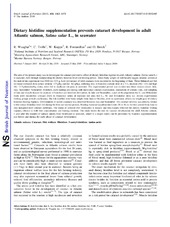Dietary histidine supplementation prevents cataract development in adult Atlantic salmon, Salmo salar L., in seawater
Peer reviewed, Journal article
Published version
Permanent lenke
https://hdl.handle.net/1956/7565Utgivelsesdato
2010-11Metadata
Vis full innførselSamlinger
Originalversjon
https://doi.org/10.1017/s0007114510002485Sammendrag
The aim of the present study was to investigate the cataract preventive effect of dietary histidine regimes in adult Atlantic salmon (Salmo salar L.) in seawater, both through manipulating the dietary histidine level and feeding period. Mean body weight of individually tagged Atlantic salmon at the start of the experiment was 1662 (SD 333) g. Low prevalence of mild cataracts were recorded in the beginning of June. Three fishmeal and fish oil-based extruded diets (crude protein: 375 g/kg and fat: 342 g/kg), differing only in histidine content (low (L): 9·3, medium (M): 12·8 and high (H): 17·2 g histidine/kg diets), were fed to duplicate net pens in seawater. The experimental period was divided into three seasons (June–July; July–September; September–October), each starting and ending with individual cataract examination, assessment of somatic data, and sampling of lens and muscle tissues for analysis of histidine and histidine derivatives. In July and September, a part of the population fed L- and H-histidine feeds were transferred (crossed over) to respective series of replicate net pens fed L-, M- and H-histidine diets (i.e. eleven experimental feeding groups at trial conclusion). The fish doubled their body weight from June to October, with no systematic effects on weight gain of dietary histidine feeding regimes. Development of severe cataracts was observed between July and September. The cataract severity was directly related to the dietary histidine level fed during the first and second periods. Feeding histidine-supplemented diets (M or H) in the first period from June to July mitigated later cataract outbreaks. The status of selected free imidazoles in muscle and lens tissues reflected the dietary histidine feeding regimes, relative to both feed concentration and feeding duration. The study shows the risk for cataract development for adult Atlantic salmon, 1 year after the transfer of salmon smolts from freshwater to seawater, which to a major extent can be prevented by histidine supplementation just before and during the early phase of cataract development.
